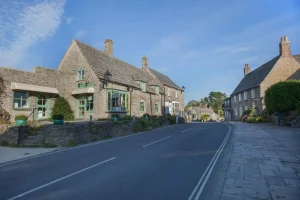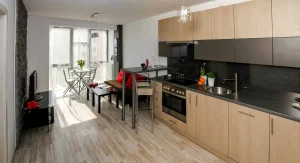
Innovative Housing Projects Smart Neighbourhoods Explained
Remember those old sci-fi movies? The ones where cities were gleaming utopias of flying cars, automated homes, and pristine green spaces. It always felt like a distant, almost laughable fantasy. Well, take a look around. While we might not have personal spaceships just yet, the core of that vision is rapidly becoming our reality. We are standing at the threshold of a revolution in how we live, not just as individuals in a house, but as communities in a connected, intelligent environment. This isn’t just about slapping some solar panels on a roof and calling it a day. This is a fundamental rethinking of what a home and a neighbourhood can and should be. It’s exciting. It’s a little intimidating. And it’s already happening.
The Dawn of a New Era: Understanding Innovative Housing Projects and Smart Neighbourhoods
The conversation around our living spaces has shifted dramatically. It’s no longer just about square footage or the number of bedrooms. Now, it’s about efficiency, sustainability, connectivity, and community. It’s a massive paradigm shift, and honestly, it’s about time. We’re finally moving from building simple shelters to creating dynamic ecosystems for living.
Defining the Core Concepts of Future Living
So, what are we even talking about here? Let’s break it down. Innovative housing is a broad term for residential construction that breaks from tradition. Think homes built with bizarrely wonderful new materials, assembled in a factory like Lego bricks for maximum efficiency, or designed to produce more energy than they consume.
A smart neighbourhood, on the other hand, is the macro-level version of a smart home. It’s a community where technology and data are used to improve the quality of life for its residents. This means everything from traffic lights that adjust to real-time flow, to public spaces with integrated Wi-Fi, to waste bins that signal when they’re full. It’s about creating a seamless, responsive, and resource-efficient urban fabric.
Why Innovation in Residential Development is Crucial Today
Why the sudden rush? Simple. The old ways aren’t working anymore. Cities are bloating, resources are dwindling, and our planet is sending us some pretty clear warning signals. We need housing that is less wasteful to build and operate. We need communities that use energy and water more intelligently. And frankly, in an increasingly isolated digital world, we need neighbourhoods that actually foster a sense of connection among people. This isn’t a luxury; it’s an absolute necessity for a sustainable and liveable future. The pressure is on.
Pioneering Design: Key Features of Innovative Housing Projects
The houses themselves are where this revolution begins. They are the building blocks of these new communities, and they look and function nothing like their predecessors. We’re talking about homes that are as intelligent as they are beautiful, and as kind to the planet as they are to your wallet.
Embracing Sustainable Materials and Eco-Conscious Architecture
I recently saw a house being built with walls made of rammed earth and structural beams made from engineered bamboo. It was gorgeous. This is the new frontier. The focus on sustainable building materials for housing is a game-changer, moving away from carbon-intensive concrete and towards options like cross-laminated timber, recycled steel, and even mycelium (yes, mushroom roots). Architects are also re-embracing ancient wisdom through passive design—orienting buildings to maximize natural light and airflow, reducing the need for artificial heating, cooling, and lighting. It’s brilliantly simple, yet incredibly effective.
The Efficiency of Modular and Prefabricated Construction
Building on-site is messy, wasteful, and time-consuming. Modular construction flips the script. Homes are built in sections, or modules, in a controlled factory environment. This process is stunningly efficient, slashing construction time, minimizing material waste, and ensuring higher quality control. Then, these modules are transported to the site and assembled. It’s faster, often cheaper, and results in a more precise and durable structure. Forget the old stigma of “prefabs”; these are high-end, custom-designed homes.
Integrating Renewable Energy for Self-Sustaining Homes
The dream of a zero-dollar energy bill is getting closer. Modern innovative homes are designed as mini power plants. They feature integrated solar panels on the roof (or even solar shingles that look like traditional roofing), geothermal heating and cooling systems that draw energy from the earth, and high-capacity battery storage systems. These homes can operate off-grid during an outage or even sell excess energy back to the utility company. It’s a profound shift from being a consumer to a producer of energy.
Smart Home Technology: Enhancing Everyday Living
This is where it gets personal. My thermostat is, for lack of a better word, dumb. I have to tell it what to do. My friend, who lives in a new build, has a system that learned their schedule and preferences within a week. It automatically adjusts the temperature for when they’re home, away, or sleeping, saving them a fortune. This is just the beginning. We’re talking about lighting that syncs with your circadian rhythm, security systems that can differentiate between a pet and an intruder, and appliances you can control from halfway around the world. It’s about convenience, security, and efficiency rolled into one.
Building Connected Futures: What Makes a Neighbourhood “Smart”?
A collection of smart homes doesn’t automatically make a smart neighbourhood. The magic happens when the entire community is woven together with a digital nervous system, creating an environment that is greater than the sum of its parts.
The Power of IoT: Seamless Connectivity and Data-Driven Efficiency
The Internet of Things (IoT) is the invisible force behind a smart community. It’s the network that allows countless devices to talk to each other. This is where the concept of IoT integration in residential communities comes to life. Your car might communicate with a sensor to find an open parking spot.
Public irrigation systems will know not to turn on if it has just rained. The entire neighbourhood operates on a stream of real-time data, allowing for unprecedented efficiency. Everything is connected, constantly sharing information to make the system as a whole run better.
Intelligent Infrastructure: Managing Resources for Urban Harmony
Beyond individual homes, smart infrastructure works silently in the background. Think about a smart grid that reroutes power to prevent blackouts during peak demand or efficiently integrates locally generated renewable energy. Imagine waste management systems where bins are only collected when they are actually full, optimizing truck routes and saving fuel. Or smart streetlights that dim when no one is around to save electricity but brighten when they detect a pedestrian. These aren’t futuristic fantasies; they are practical solutions being deployed right now.
Prioritizing Community Well-being, Safety, and Green Spaces
It can’t all be about tech and data. A truly smart neighbourhood uses technology to enhance human experience. This means well-designed, accessible green spaces, public Wi-Fi in parks, and community apps that connect neighbours for everything from borrowing a tool to organizing a block party. Safety is also paramount, with intelligent camera systems and emergency response networks that can reduce response times and make residents feel more secure. It’s about using technology to foster, not replace, community.
Sustainable Mobility: Transforming Urban Transportation
Our reliance on personal cars is a major source of congestion and pollution. Smart neighbourhoods tackle this head-on by promoting sustainable mobility. This includes creating highly walkable and bike-friendly layouts, providing dedicated lanes for e-scooters, and integrating shared transportation services like e-bikes and electric cars. The ultimate goal is to create a community where owning a personal car is an option, not a necessity.
The Tangible Benefits of Living in an Innovative and Smart Community
This all sounds impressive, but what does it actually feel like to live in one of these places? The benefits are tangible, affecting everything from your bank account to your health and happiness.
Environmental Stewardship and a Reduced Carbon Footprint
The most obvious benefit is environmental. By combining energy-efficient home design, renewable energy generation, smart resource management, and sustainable transportation, these communities drastically reduce their ecological footprint. Living here means actively participating in a more sustainable way of life, which is a powerful feeling.
Economic Advantages: Cost Savings and Long-Term Value
The economic case is incredibly compelling. While the upfront cost might be higher, the long-term savings are substantial. Lower (or non-existent) utility bills, reduced transportation costs, and fewer maintenance needs add up quickly. Moreover, these forward-thinking features make homes in these communities highly desirable, leading to strong property value appreciation over time. It’s a wise investment in every sense of the word.
Elevating Quality of Life Through Technology and Design
Let’s talk about how smart neighbourhoods improve life on a daily basis. It’s about the time you save when your commute is shorter or you never have to circle for parking. It’s the peace of mind that comes from a safer, more secure environment. It’s the simple pleasure of living in a home that is always comfortable and responsive to your needs. Technology and thoughtful design work together to remove daily frictions, leaving you with more time and energy for the things that truly matter.
Fostering Stronger Bonds and a Sense of Belonging
Ironically, a high-tech environment can lead to a more high-touch community. When neighbourhoods are designed with shared spaces, community gardens, and walkable centres, people are more likely to interact. Add in digital tools that make it easy to connect, and you have a recipe for a vibrant, tight-knit community. These innovative communities are proving that technology can be a bridge, not a barrier, to human connection.
Navigating the Path Forward: Challenges and Solutions
Of course, this transition isn’t without its hurdles. It sounds like a perfect utopia, but let’s be real, there are significant challenges to overcome before this becomes the new standard everywhere.
Overcoming Initial Investment Hurdles
The elephant in the room is cost. Developing this advanced infrastructure and using cutting-edge materials requires a significant upfront investment. This can make these homes unaffordable for many. The solution lies in a combination of government incentives, innovative financing models, and the scaling of technology, which will gradually bring down costs over time.
Addressing Data Privacy and Digital Security Concerns
Here’s my biggest hang-up. A community that runs on data is also a community vulnerable to data breaches. Who owns all this information? How is it being used? Ensuring robust digital security and transparent data privacy policies is not just important; it is absolutely critical to building public trust. The last thing anyone wants is to get a targeted ad because their smart fridge knows they’re low on milk. It’s a legitimate and serious concern.
Ensuring Inclusivity and Accessibility in Smart Environments
We must ensure that these advancements benefit everyone, not just the tech-savvy or the wealthy. Technology must be designed with accessibility in mind for the elderly and people with disabilities. Furthermore, a concerted effort is needed to develop affordable housing within these communities to prevent the creation of exclusive, high-tech enclaves. A smart city should be a city for all.
Realizing the Vision: Inspiring Examples of Smart Communities
This isn’t just theory. Pockets of the future are already being built around the globe, serving as living laboratories for what works.
Global Case Studies in Sustainable Urban Innovation
From the eco-districts in Scandinavia that prioritize district heating and sustainable transport to the technologically advanced developments in Japan focused on energy management and elder care, we see these principles in action. Each project is unique, tailored to its local climate and culture, but they all share a common DNA of sustainability, technology, and community focus. These pioneering efforts provide invaluable real-world data and inspiration.
Blueprints for Tomorrow: What We Can Learn
What can we learn from these early adopters? That success requires deep collaboration between developers, city planners, tech companies, and, most importantly, the residents themselves. It’s clear that the most successful projects are those that prioritize people over technology, using tech as a tool to achieve human-centric goals. The blueprint for the future is collaborative and citizen-focused.
The Road Ahead: Future Trends in Innovative Housing and Smart Neighbourhoods
The pace of change is only accelerating. What seems cutting-edge today will be standard tomorrow, and new breakthroughs are on the horizon.
Emerging Technologies Shaping the Urban Landscape
Keep an eye on trends like hyper-local energy grids, the use of AI for predictive urban management, and even autonomous drones for deliveries and infrastructure inspection. 3D printing technology is also poised to revolutionize construction, potentially allowing for the creation of customized, affordable homes on a massive scale. The future will be even more automated, data-rich, and interconnected.
The Role of Policy and Collaborative Planning
Technology alone can’t build a better future. We need forward-thinking public policy, updated zoning laws that encourage innovation, and robust public-private partnerships. Cities must create master plans that integrate these new concepts, ensuring that development is strategic, equitable, and sustainable for the long term.
Conclusion: Paving the Way for a Brighter, Smarter Residential Future
We are at a pivotal moment. The convergence of environmental necessity, technological capability, and a renewed focus on community is creating a once-in-a-generation opportunity to redefine where and how we live. The path is complex, filled with both immense promise and significant challenges.
But the vision of a cleaner, more efficient, more connected, and more enjoyable way of life is a powerful motivator. By embracing new ideas and working together, we can move beyond the fantasies of old sci-fi films and start building the real-world innovative communities that will be home to generations to come. The future is not just something we wait for; it is something we are building, one smart home at a time.






